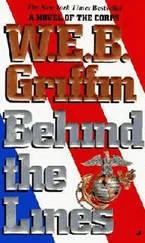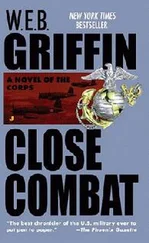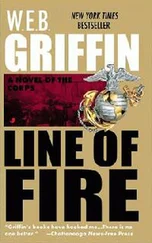W.E.B. Griffin - The Corps IV - Battleground
Здесь есть возможность читать онлайн «W.E.B. Griffin - The Corps IV - Battleground» весь текст электронной книги совершенно бесплатно (целиком полную версию без сокращений). В некоторых случаях можно слушать аудио, скачать через торрент в формате fb2 и присутствует краткое содержание. Жанр: prose_military, на английском языке. Описание произведения, (предисловие) а так же отзывы посетителей доступны на портале библиотеки ЛибКат.
- Название:The Corps IV - Battleground
- Автор:
- Жанр:
- Год:неизвестен
- ISBN:нет данных
- Рейтинг книги:4 / 5. Голосов: 1
-
Избранное:Добавить в избранное
- Отзывы:
-
Ваша оценка:
- 80
- 1
- 2
- 3
- 4
- 5
The Corps IV - Battleground: краткое содержание, описание и аннотация
Предлагаем к чтению аннотацию, описание, краткое содержание или предисловие (зависит от того, что написал сам автор книги «The Corps IV - Battleground»). Если вы не нашли необходимую информацию о книге — напишите в комментариях, мы постараемся отыскать её.
The Corps IV - Battleground — читать онлайн бесплатно полную книгу (весь текст) целиком
Ниже представлен текст книги, разбитый по страницам. Система сохранения места последней прочитанной страницы, позволяет с удобством читать онлайн бесплатно книгу «The Corps IV - Battleground», без необходимости каждый раз заново искать на чём Вы остановились. Поставьте закладку, и сможете в любой момент перейти на страницу, на которой закончили чтение.
Интервал:
Закладка:
"Yes, Sir."
"There are several things going on over there in which we have an interest. Since you have no need to know what they are..."
"I understand, Sir."
"We may need replacements for the incumbents. An ideal replacement would be an officer of appropriate grade, who had already gone through the FBI's screening and been declared ninety-nine and forty-four one-hundredths percent pure on the morals scale-like Ivory soap. And who was not only over there, but in a position to know more of what's going on than, say, a battalion commander. Or for that matter, a division G-2. A liaison officer, for example."
"I think I understand, Sir," Dailey replied, very seriously.
"Think of yourself as a spare tire, Colonel. I devoutly hope we never have to take you out of the trunk."
"Yes, Sir."
(Two)
CAPE ESPERANCE
GUADALCANAL, SOLOMON ISLANDS
7 AUGUST 1942
At 0200, the Amphibious Force of OPERATION PESTILENCE, Transport Groups X and Y, reached Savo Island, which lies between Guadalcanal and Florida islands. The skies were clear, and there was enough light from a quarter moon to make out both the land masses and the other ships.
The fifteen transports of Transport Group X carried aboard the major elements of the 1st Marine Division and were headed for the beaches of Guadalcanal. These turned and entered Sealark Channel, which runs between Savo and Guadalcanal.
Meanwhile, Transport Group Y sailed along the other side of Savo Island, that is, between Savo and Florida Island, and headed toward their destinations, Florida, Tulagi and Gavutu islands. Transport Group Y consisted of four transports carrying the 2nd Battalion, Sth Marines, and other troops, and four destroyer transports carrying the 1st Raider Battalion. These were World War I destroyers that had been converted for use by Marine Raiders by removing two of their four engines and converting the space to troop berthing.
The Guadalcanal Invasion Force was headed for what the Operations Plan called "Beach Red." This was a spot about 6,000 yards East of Lunga Point, more or less directly across Sealark Channel from where the Tulagi-Gavutu landings were to take place. The distance across Sealark Channel was approximately twenty-five miles.
Three U.S. Navy cruisers and four destroyers began to shell the Guadalcanal landing area at 0614. It had already been bombed daily for a week by U.S. Army Air Corps B-17s. At 0616, one cruiser and two destroyers opened fire on Tulagi and Gavutu.
By 0651 the transports of both groups dropped anchor 9,000 yards off their respective landing beaches. Landing boats were put over the side into the calm water, and Marines began to climb down rope nets into them.
Mine sweepers working the water between the ships and their landing beaches encountered no mines, but a small Japanese schooner carrying gasoline wandered into Sealark Channel. It was set afire and quickly sunk by Naval gunfire and machine gun fire from Navy fighter aircraft and dive bombers These were operating from carriers maneuvering seventy-five miles away from the invasion beaches.
The Navy sent forty-three carrier aircraft to attack the Guadalcanal invasion beach, and forty-one to attack Tulagi ,and Gavutu. Eighteen Japanese seaplanes at Tulagi were destroyed.
At 0740, B Company, 1st Battalion, 2nd Marines, went ashore near the small village of Haleta, on Florida Island. They encountered no resistance.
At 0800, the First Wave of the Tulagi Force, Landing Craft carrying Baker and Dog Companies of the 1st Raider Battalion, touched ashore on Blue Beach. A Marine was killed almost immediately by a single rifle shot, but there was no other resistance on the beach. The enemy had elected to defend Tulagi from caves and earthen bunkers in the hills inland and to the South.
The Landing Craft returned to the transports, loaded the Second Wave (Able and Charley Companies, 1st Raiders), and put them ashore. Then a steady stream of Landing Craft put 2nd Battalion, 5th Marines on shore.
Once on Tulagi, the 2nd Battalion, 5th Marines crossed the narrow island to their left (Northwest), to clear out the enemy, while the Raiders turned to their right (Southeast) and headed toward the Southern tip of Tulagi. About thirty-five hundred yards separated the Southern tip of Tulagi from the tiny island of Gavutu (515 by 255 yards) and the even smaller (290 by 310) island of Tanambogo, which was connected to Gavutu by a concrete causeway.
The Raiders encountered no serious opposition until after noon. And 2nd Battalion, 5th Marines, encountered no serious opposition moving in the opposite direction until about the same time.
Off Guadalcanal, at 0840, the destroyers of the Guadalcanal Fire Support Group took up positions to mark the line of departure for the Landing Craft, 5000 yards North of Beach Red. Simultaneously, small liaison aircraft (Piper Cubs) appeared over Beach Red, and marked its 3200 yard width with smoke grenades.
At exactly 0900, all the cruisers and destroyers of the Guadalcanal Fire Support Group began to bombard Beach Red and the area extending 200 yards inshore.
The Landing Craft carrying the first wave of the Beach Red invasion force (the 5th Marines, less their 2nd Battalion, which was at that moment in the process of landing on Tulagi) left the departure line on schedule. When the Landing Craft were 1300 yards off Beach Red, the covering bombardment was lifted.
At 0910, on a 1600 yard front, the 5th Marines began to land on the beach, the 1st Battalion on the right (West) and the 3rd Battalion on the left (East). Regimental Headquarters came ashore at 0938, and minutes later it was joined by the Heavy Weapons elements of the regiment.
Again, there was virtually no resistance on the beach.
As the Landing Craft returned to the transports to bring the 1st Marines ashore, the 5th Marines moved inland, setting up a defense perimeter 600 yards off Beach Red, along the Tenaru River on the West, the Tenavatu River on the East, and a branch of the Tenaru on the South.
Once it had become apparent that they would not be in danger from Japanese artillery on or near the beach, the transports began to move closer to shore, dropping anchor again 7000 yards away.
At about this point, serious problems began with the offloading process, in many ways duplicating the disastrous trial run in the Fiji Islands.
The small and relatively easy to manhandle 75mm pack howitzers (originally designed to be carried by mules) of the 11th Marines (the artillery regiment) had come ashore with the assault elements of the 5th Marines.
The 105mm howitzers now came ashore. But their emplacement was hindered because there were not enough drop-ramp Landing Craft to handle their "prime-movers," the trucks which tow the cannon. The "prime mover" for the 105mm howitzer was supposed to be a 2" -ton, 6x6 truck. The 11th Marines had been issued instead a truck commonly referred to as a "one-ton." Instead of the six (actually ten) powered wheels of the "deuce and a half," it had only four powered wheels to drive it through mud, sand, or slippery terrain.,
It was this much smaller, inadequate, one-ton "prime mover" for which there were insufficient drop-bow Landing Craft to move immediately onto Beach Red.
So when the 105mm howitzers arrived on the beach, the only vehicles capable of towing them inland to firing positions were the few, overworked, Amphibious Tractors. These had a tank-like track and could negotiate sand and mud.
They were pressed into service to move the 105mm howitzers. In doing that, however, their metal tracks chewed up the primitive roads and whatever field telephone wires they crossed, effectively cutting communication between the advanced positions, the beach, and the several headquarters.
Within an hour or so of landing on the beach, moreover, the Marines were physically exhausted. For one thing, because of the long time they had spent aboard the troop transports, they had lost much of the physical toughness they'd acquired in training.
Читать дальшеИнтервал:
Закладка:
Похожие книги на «The Corps IV - Battleground»
Представляем Вашему вниманию похожие книги на «The Corps IV - Battleground» списком для выбора. Мы отобрали схожую по названию и смыслу литературу в надежде предоставить читателям больше вариантов отыскать новые, интересные, ещё непрочитанные произведения.
Обсуждение, отзывы о книге «The Corps IV - Battleground» и просто собственные мнения читателей. Оставьте ваши комментарии, напишите, что Вы думаете о произведении, его смысле или главных героях. Укажите что конкретно понравилось, а что нет, и почему Вы так считаете.









